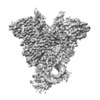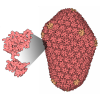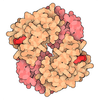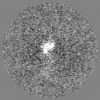+ Open data
Open data
- Basic information
Basic information
| Entry | Database: EMDB / ID: EMD-20035 | |||||||||
|---|---|---|---|---|---|---|---|---|---|---|
| Title | Cryo-EM structure of mouse RAG1/2 NFC complex (DNA2) | |||||||||
 Map data Map data | mouse RAG1/2 NFC complex | |||||||||
 Sample Sample |
| |||||||||
 Keywords Keywords | V(D)J recombination / DNA Transposition / RAG / SCID / RECOMBINATION / RECOMBINATION-DNA complex | |||||||||
| Function / homology |  Function and homology information Function and homology informationnon-sequence-specific DNA binding, bending / mature B cell differentiation involved in immune response / B cell homeostatic proliferation / negative regulation of T cell differentiation in thymus / DN2 thymocyte differentiation / pre-B cell allelic exclusion / DNA geometric change / positive regulation of organ growth / bubble DNA binding / regulation of behavioral fear response ...non-sequence-specific DNA binding, bending / mature B cell differentiation involved in immune response / B cell homeostatic proliferation / negative regulation of T cell differentiation in thymus / DN2 thymocyte differentiation / pre-B cell allelic exclusion / DNA geometric change / positive regulation of organ growth / bubble DNA binding / regulation of behavioral fear response / V(D)J recombination / negative regulation of T cell apoptotic process / phosphatidylinositol-3,4-bisphosphate binding / negative regulation of thymocyte apoptotic process / histone H3K4me3 reader activity / phosphatidylinositol-3,5-bisphosphate binding / supercoiled DNA binding / regulation of T cell differentiation / DNA binding, bending / organ growth / positive regulation of T cell differentiation / T cell lineage commitment / B cell lineage commitment / endoplasmic reticulum-Golgi intermediate compartment / phosphatidylinositol-3,4,5-trisphosphate binding / T cell homeostasis / T cell differentiation / protein autoubiquitination / four-way junction DNA binding / phosphatidylinositol-4,5-bisphosphate binding / phosphatidylinositol binding / thymus development / B cell differentiation / RING-type E3 ubiquitin transferase / visual learning / autophagy / chemotaxis / ubiquitin-protein transferase activity / ubiquitin protein ligase activity / T cell differentiation in thymus / chromosome / chromatin organization / endonuclease activity / DNA recombination / histone binding / sequence-specific DNA binding / adaptive immune response / Hydrolases; Acting on ester bonds / endosome / defense response to bacterium / inflammatory response / innate immune response / DNA repair / chromatin binding / regulation of transcription by RNA polymerase II / protein homodimerization activity / DNA binding / extracellular region / zinc ion binding / nucleoplasm / metal ion binding / identical protein binding / nucleus / plasma membrane Similarity search - Function | |||||||||
| Biological species |    | |||||||||
| Method | single particle reconstruction / cryo EM / Resolution: 3.29 Å | |||||||||
 Authors Authors | Chen X / Cui Y / Zhou ZH / Yang W / Gellert M | |||||||||
| Funding support |  United States, 1 items United States, 1 items
| |||||||||
 Citation Citation |  Journal: Nat Struct Mol Biol / Year: 2020 Journal: Nat Struct Mol Biol / Year: 2020Title: Cutting antiparallel DNA strands in a single active site. Authors: Xuemin Chen / Yanxiang Cui / Robert B Best / Huaibin Wang / Z Hong Zhou / Wei Yang / Martin Gellert /  Abstract: A single enzyme active site that catalyzes multiple reactions is a well-established biochemical theme, but how one nuclease site cleaves both DNA strands of a double helix has not been well ...A single enzyme active site that catalyzes multiple reactions is a well-established biochemical theme, but how one nuclease site cleaves both DNA strands of a double helix has not been well understood. In analyzing site-specific DNA cleavage by the mammalian RAG1-RAG2 recombinase, which initiates V(D)J recombination, we find that the active site is reconfigured for the two consecutive reactions and the DNA double helix adopts drastically different structures. For initial nicking of the DNA, a locally unwound and unpaired DNA duplex forms a zipper via alternating interstrand base stacking, rather than melting as generally thought. The second strand cleavage and formation of a hairpin-DNA product requires a global scissor-like movement of protein and DNA, delivering the scissile phosphate into the rearranged active site. | |||||||||
| History |
|
- Structure visualization
Structure visualization
| Movie |
 Movie viewer Movie viewer |
|---|---|
| Structure viewer | EM map:  SurfView SurfView Molmil Molmil Jmol/JSmol Jmol/JSmol |
| Supplemental images |
- Downloads & links
Downloads & links
-EMDB archive
| Map data |  emd_20035.map.gz emd_20035.map.gz | 78.3 MB |  EMDB map data format EMDB map data format | |
|---|---|---|---|---|
| Header (meta data) |  emd-20035-v30.xml emd-20035-v30.xml emd-20035.xml emd-20035.xml | 22.7 KB 22.7 KB | Display Display |  EMDB header EMDB header |
| Images |  emd_20035.png emd_20035.png | 59.5 KB | ||
| Filedesc metadata |  emd-20035.cif.gz emd-20035.cif.gz | 7.9 KB | ||
| Archive directory |  http://ftp.pdbj.org/pub/emdb/structures/EMD-20035 http://ftp.pdbj.org/pub/emdb/structures/EMD-20035 ftp://ftp.pdbj.org/pub/emdb/structures/EMD-20035 ftp://ftp.pdbj.org/pub/emdb/structures/EMD-20035 | HTTPS FTP |
-Validation report
| Summary document |  emd_20035_validation.pdf.gz emd_20035_validation.pdf.gz | 532.6 KB | Display |  EMDB validaton report EMDB validaton report |
|---|---|---|---|---|
| Full document |  emd_20035_full_validation.pdf.gz emd_20035_full_validation.pdf.gz | 532.2 KB | Display | |
| Data in XML |  emd_20035_validation.xml.gz emd_20035_validation.xml.gz | 6.2 KB | Display | |
| Data in CIF |  emd_20035_validation.cif.gz emd_20035_validation.cif.gz | 7.1 KB | Display | |
| Arichive directory |  https://ftp.pdbj.org/pub/emdb/validation_reports/EMD-20035 https://ftp.pdbj.org/pub/emdb/validation_reports/EMD-20035 ftp://ftp.pdbj.org/pub/emdb/validation_reports/EMD-20035 ftp://ftp.pdbj.org/pub/emdb/validation_reports/EMD-20035 | HTTPS FTP |
-Related structure data
| Related structure data |  6oerMC  6oemC  6oenC  6oeoC  6oepC  6oeqC  6v0vC C: citing same article ( M: atomic model generated by this map |
|---|---|
| Similar structure data |
- Links
Links
| EMDB pages |  EMDB (EBI/PDBe) / EMDB (EBI/PDBe) /  EMDataResource EMDataResource |
|---|---|
| Related items in Molecule of the Month |
- Map
Map
| File |  Download / File: emd_20035.map.gz / Format: CCP4 / Size: 83.7 MB / Type: IMAGE STORED AS FLOATING POINT NUMBER (4 BYTES) Download / File: emd_20035.map.gz / Format: CCP4 / Size: 83.7 MB / Type: IMAGE STORED AS FLOATING POINT NUMBER (4 BYTES) | ||||||||||||||||||||||||||||||||||||||||||||||||||||||||||||
|---|---|---|---|---|---|---|---|---|---|---|---|---|---|---|---|---|---|---|---|---|---|---|---|---|---|---|---|---|---|---|---|---|---|---|---|---|---|---|---|---|---|---|---|---|---|---|---|---|---|---|---|---|---|---|---|---|---|---|---|---|---|
| Annotation | mouse RAG1/2 NFC complex | ||||||||||||||||||||||||||||||||||||||||||||||||||||||||||||
| Projections & slices | Image control
Images are generated by Spider. | ||||||||||||||||||||||||||||||||||||||||||||||||||||||||||||
| Voxel size | X=Y=Z: 1.07 Å | ||||||||||||||||||||||||||||||||||||||||||||||||||||||||||||
| Density |
| ||||||||||||||||||||||||||||||||||||||||||||||||||||||||||||
| Symmetry | Space group: 1 | ||||||||||||||||||||||||||||||||||||||||||||||||||||||||||||
| Details | EMDB XML:
CCP4 map header:
| ||||||||||||||||||||||||||||||||||||||||||||||||||||||||||||
-Supplemental data
- Sample components
Sample components
+Entire : RAG1/2 Nick-forming complex (DNA2)
+Supramolecule #1: RAG1/2 Nick-forming complex (DNA2)
+Macromolecule #1: V(D)J recombination-activating protein 1
+Macromolecule #2: V(D)J recombination-activating protein 2
+Macromolecule #7: High mobility group protein B1
+Macromolecule #3: DNA (46-MER)
+Macromolecule #4: DNA (46-MER)
+Macromolecule #5: DNA (57-MER)
+Macromolecule #6: DNA (57-MER)
+Macromolecule #8: ZINC ION
+Macromolecule #9: CALCIUM ION
-Experimental details
-Structure determination
| Method | cryo EM |
|---|---|
 Processing Processing | single particle reconstruction |
| Aggregation state | particle |
- Sample preparation
Sample preparation
| Buffer | pH: 7.4 |
|---|---|
| Grid | Details: unspecified |
| Vitrification | Cryogen name: ETHANE |
- Electron microscopy
Electron microscopy
| Microscope | FEI TITAN KRIOS |
|---|---|
| Image recording | Film or detector model: GATAN K2 SUMMIT (4k x 4k) / Average electron dose: 50.0 e/Å2 |
| Electron beam | Acceleration voltage: 300 kV / Electron source:  FIELD EMISSION GUN FIELD EMISSION GUN |
| Electron optics | Illumination mode: FLOOD BEAM / Imaging mode: BRIGHT FIELD |
| Experimental equipment |  Model: Titan Krios / Image courtesy: FEI Company |
 Movie
Movie Controller
Controller




























 Z (Sec.)
Z (Sec.) Y (Row.)
Y (Row.) X (Col.)
X (Col.)





















 Homo sapiens (human)
Homo sapiens (human)